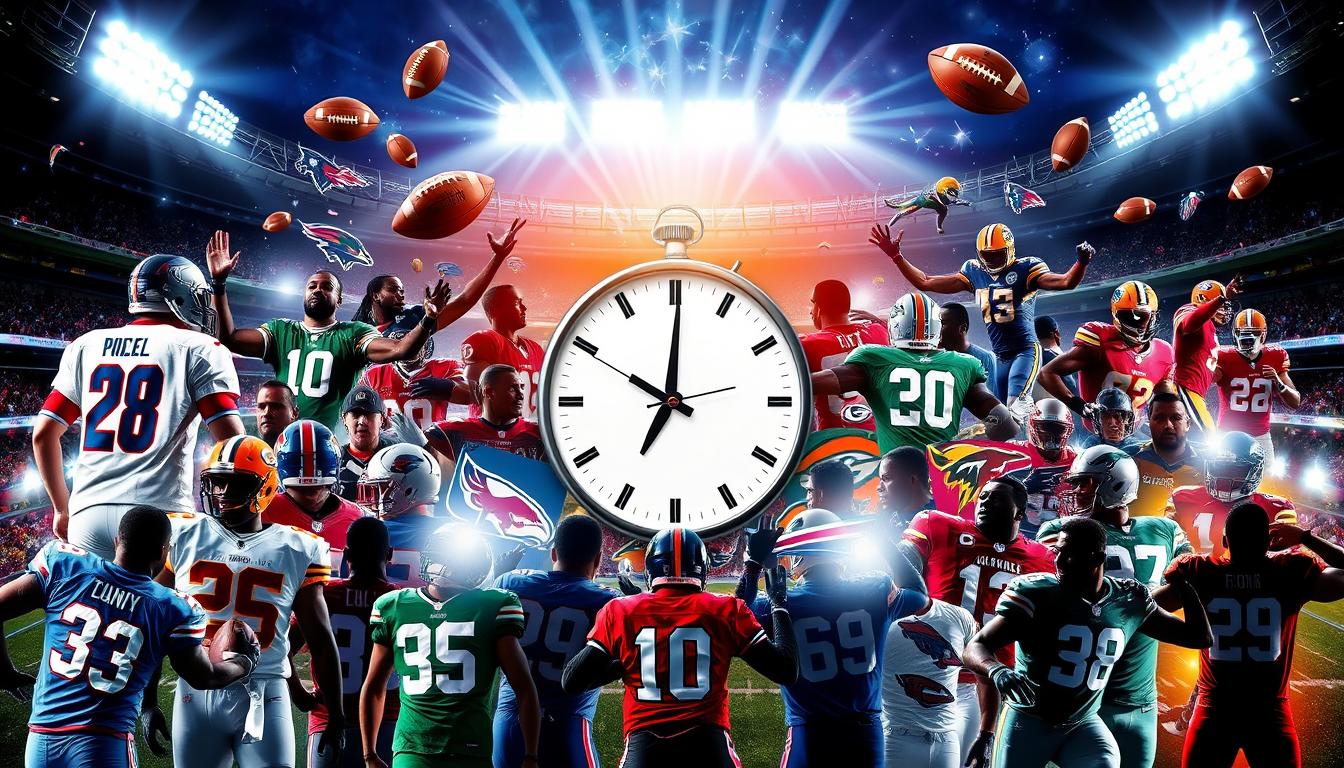“In the world of sports, the game never ends, it simply evolves.” – Anonymous. This quote shows how sports are always changing. Especially with the sports media rights fees 2024. We’ll look at how these fees affect US sports television contracts.
It’s key to understand their role in shaping broadcasting trends. This summary will give you important details. You’ll learn about the big fee increases expected in 2024. Plus, we’ll compare the major leagues and share expert views on sports broadcasting deals.
By looking at these trends, you’ll see how media rights agreements affect league revenues. They also shape the sports industry’s overall dynamics. Let’s dive into the world of media rights and its impact on leagues, networks, and fans.
For more detailed insights and figures, refer to the comprehensive overview provided throughout the article1.
The Importance of Media Rights Fees in Sports
Media rights fees are key in the sports world. They help leagues and teams make money. This money goes to player salaries, improving facilities, and helping the community.
These fees also make live sports more accessible to fans. Networks pay a lot to show games, giving fans a wide range of content. This makes watching sports more enjoyable.
Media rights fees also boost ticket sales and merchandise. Leagues can make games more affordable or offer deals. This draws more fans to live games, improving the atmosphere and team loyalty.
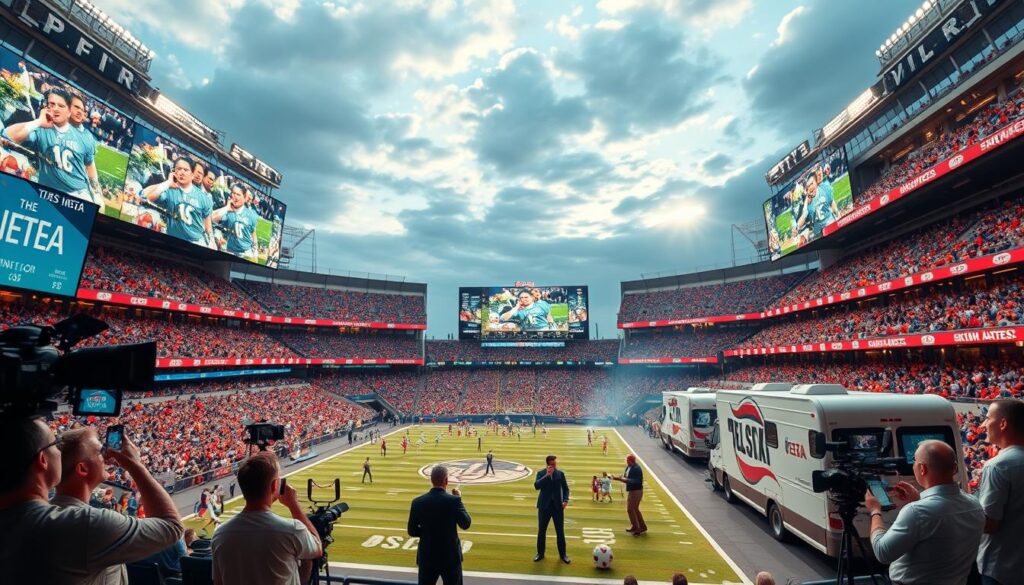
The fight for exclusive rights leads to new ways to watch sports. This is good for both traditional networks and streaming services. For example, the NFL’s viewership has grown by 10% to 18.6 million viewers2.
Overview of Major US Leagues
The Major US sports leagues are diverse and rich. They include the NFL, NBA, MLB, and NHL. Each league has a huge audience and strong market presence. The NFL tops with 18.6 million viewers, its best since 2015, showing a 10% rise from last year.
Media rights are a big deal for these leagues. The MLB’s deals are crucial, with Super Bowls in New Orleans, Santa Clara, and L.A. showing the league’s growth. The NBA is also growing, with a focus on international fans, just like the NFL’s Global Markets program.
The NHL is gaining fans, with a focus on digital streaming and fan engagement. These leagues are all connected, adapting to changes in the sports media world. Women’s sports, like Arsenal Women, are getting more attention, showing the sports world is becoming more inclusive.

Current Trends in Sports Media Rights
The world of sports media rights is changing fast. More people want to watch sports online. This means big networks are facing tough competition from streaming services.
These new players are changing how leagues make deals. They’re getting better terms that fit the new digital world.

Networks are changing how they reach fans. People are watching sports on different platforms. This makes leagues look for new ways to broadcast games.
This change shows how important digital strategies are. They help leagues reach more people.
As the industry grows, expect new ways to watch sports. Teams are working hard to grow their global presence. They’re using social media to connect with fans.
It’s key for everyone involved to understand these changes. This helps them stay ahead in the fast-changing world of sports media rights.
The NFL is currently averaging 18.6 million viewers, the best average through Week 3 since 2015, with a 10% increase from the previous year2.
Sports Media Rights Fees 2024 for Major US Leagues
The world of sports media rights is changing fast in 2024. This change is due to new ways of watching sports and what fans want to see. Expect big increases in media rights fees for different leagues. Experts have looked at how each league makes its deals, showing their unique strategies.
Projected Increases in Fees
Broadcast networks are fighting hard for sports rights in 2024. The NFL, for example, could see a 20% rise in fees. This is because more people are watching sports, making networks want to pay more for the rights.
Key League Deal Comparisons
The MLB and NBA deals are especially interesting. The MLB just got a 10-year deal worth over $5 billion, a big jump from before. The NBA is also looking to increase its fees by up to 15%, thanks to more fans worldwide and online streaming.

These changes show how important sports rights are for leagues’ money health. Knowing about these increases helps us see the big economic effect on US sports leagues3.
Impact of Digital Streaming on Media Rights
Digital streaming has changed the sports world a lot. More people want to watch sports online, so leagues are changing how they work. Services like Amazon Prime and Peacock are getting more popular, leading to more online rights deals.
Streaming sites attract young viewers, making them key for sports leagues. Studies show people like watching games on different devices whenever they want. This change makes old TV stations rethink their place in the digital world.
Now, sports groups are making new streaming deals to keep fans interested. They’re using online-first ideas to talk directly with fans, making watching sports better.
This change is big for traditional TV. They need to work with digital sites to keep viewers. As more people want to watch online, how we see sports will keep changing.

As leagues adapt to these changes, the future may hold exciting possibilities for sports media.
Digital streaming and media rights are creating new ways to share sports content. With more fans using social media and apps, leagues must use these trends well. The impact of digital streaming will keep shaping sports and media rights4.
Historical Context of Media Rights Fees
The history of sports broadcasting shows a big change in media rights fees. In the early days, fees were small because there were few TV stations. The Super Bowl was a big deal, starting with big money deals.
As TV technology got better, people wanted more sports. Cable TV gave more options, leading to bigger deals. The internet boom in the late 1990s and early 2000s made things even more competitive.
Now, media rights deals are huge. The rise in sports popularity and new ways to watch games have pushed prices up. Streaming services have changed the game, making deals even bigger.
The table below shows how media rights fees have grown over time:
| Year | Event | Media Rights Fee (in billions) |
|---|---|---|
| 1985 | Initial NFL TV Contracts | $1.5 |
| 1998 | NBA’s $2.4B Deal | $2.4 |
| 2007 | MLB’s $8.5B Package | $8.5 |
| 2011 | NFL’s $4B Annual Revenue Deal | $4.0 |
| 2023 | Latest Major League Deals | $10.4 |
This history shows how big deals have changed sports broadcasting. It helps us understand the future of media rights in a fast-changing world.
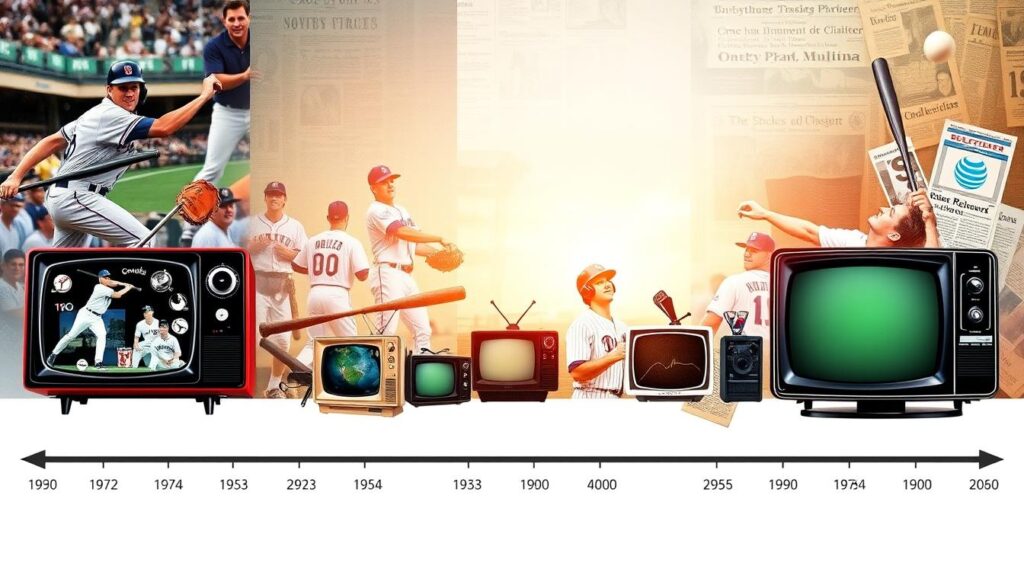
Major Networks and Their Partnerships
The world of sports broadcasting is shaped by big names like ESPN and Fox Sports. These networks play a huge role in how leagues make money. They’ve formed partnerships that help leagues and fans enjoy sports more.
ESPN and Its Influence
ESPN’s role in sports media is huge. It has been a leader in sports broadcasting, attracting lots of viewers. ESPN’s wide reach has changed how fans watch sports, leading to big deals with leagues.
The network keeps investing in new shows and tech to keep viewers engaged. This makes ESPN a key player in securing deals that shape the industry’s money flow.
Fox Sports’ Strategic Agreements
Fox Sports has made strong partnerships to grow its sports media presence. It has deals for big events like the NFL and MLB, offering a great lineup for viewers. These partnerships help Fox Sports reach different audiences and gain an edge.
By focusing on unique content and working with others, Fox Sports grabs viewers’ attention. This strategy helps them make more money from ads.
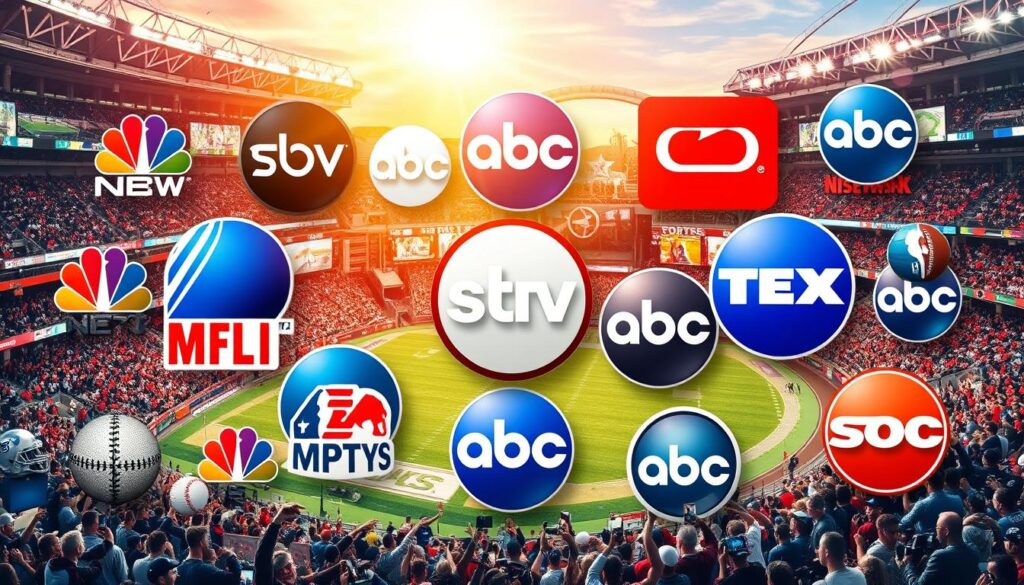
How Media Rights Fees Affect League Revenues
Media rights fees are key to the financial health of sports leagues in the U.S. They help with operations, player salaries, and marketing. Leagues that use media rights well see big boosts in their finances.
Many leagues use media rights money to improve team facilities. This helps teams compete better and engage fans more. A steady flow of media rights money helps leagues stay afloat during tough times.
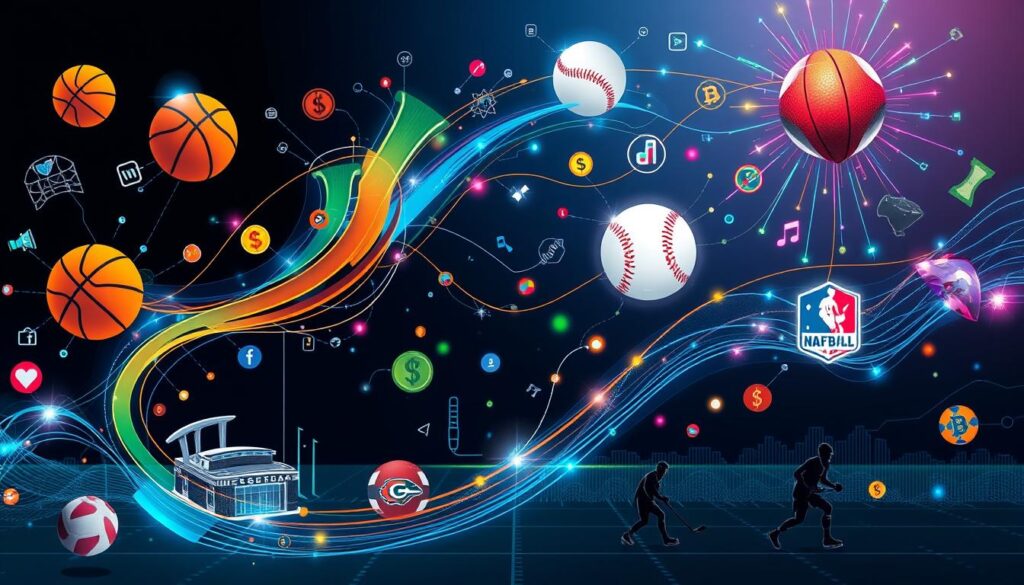
Case studies show how smart use of media rights can help leagues grow. For example, some lesser-known leagues have thrived thanks to big media deals. These deals have helped them grow their fan bases and become more financially stable.
Media rights do more than just bring in money. They also help leagues reach new fans through marketing. This is key for a strong future in sports.
| League | Media Rights Deal Value (in millions) | Number of Teams | Years Left on Deal |
|---|---|---|---|
| National Football League (NFL) | 10000 | 32 | 10 |
| National Basketball Association (NBA) | 2400 | 30 | 9 |
| Major League Baseball (MLB) | 1500 | 30 | 6 |
It’s crucial to understand how media rights affect sports financing. Leagues that make the most of media rights lead in innovation and profit. This knowledge helps make smart decisions for the league and its teams5.
Major Upcoming Broadcast Deals
The world of broadcast deals is changing fast. This change shows big shifts in how sports leagues deal with media rights. Leagues are now looking to make new partnerships that better meet fan needs and use the latest technology.
Potential Shifts in Partnerships
The NFL has big plans for the future, like awarding Super Bowl LXII to Atlanta in 20282. This move is part of a bigger plan to improve the area around Mercedes-Benz Stadium. It will make the Super Bowl more attractive to sponsors and advertisers2.
Other big events are also on the horizon. New Orleans will host in 2025, Santa Clara in 2026, and Los Angeles in 20272.
Teams like the Dolphins, Seahawks, and Lions are expanding their global presence. They’re hiring staff for the NFL Global Markets program2. The Vikings have already started by adding key people for international marketing and sales2.

The NFL is exploring new ways to grow, with the Chiefs and Cowboys leading the charge. They’re looking to expand their reach without full-time roles. The NFL’s partnership with Verizon shows its commitment to diversity and talent development2.
With 18.6 million viewers on average, the NFL is a major player in sports broadcasting. This makes it a key player in media rights negotiations, shaping the future of broadcast deals2.
The Role of Sports Content Licensing
In today’s fast-changing sports media world, sports content licensing is key. Licensing agreements help leagues make money. At the same time, new ways to share content are making sports more accessible to fans. This part explains how these agreements help leagues earn more and improve the fan experience.
Innovations in Content Distribution
New ways to share sports are changing how we watch games. Thanks to better streaming and mobile access, fans can watch their teams whenever they want. This change meets fans’ needs and shows how important sports content licensing is.
- Improved streaming platforms offer better experiences for watching sports.
- Mobile apps let viewers get live scores, highlights, and replays easily.
- Interactive features make watching sports more engaging.
The growth of direct-to-consumer models shows how new ways to share sports are changing licensing. Leagues can now connect with fans in new ways, changing old media partnerships.
| Aspect | Traditional Broadcast | Innovative Streaming |
|---|---|---|
| Accessibility | Restricted to TV schedules | On-demand access anywhere |
| Viewer Engagement | Limited interactivity | Interactive features available |
| Revenue Models | Ad-based revenue | Subscription and ad revenue |
As the industry grows, leagues and media companies will work closer together. This will be thanks to licensing agreements and new tech in sharing content6. This partnership will help leagues reach more people and make money while keeping fans happy.

Challenges in Sports Industry Negotiations
The sports industry faces many challenges in negotiations. These issues make it hard to get media rights deals done. Legal complexities and different views among leagues, networks, and teams add to the problem. Conflicts in broadcasting make things even tougher, requiring all sides to work together for profit.
Recent deals have shown how competitive the sports world is. For example, the NFL’s viewership has hit a high, with 18.6 million watching on average. This is the best since 20152. Networks are fighting hard to get these rights, leading to tough negotiations.
Stakeholders must also deal with new tech and changing consumer habits. Digital platforms are becoming more popular, causing old broadcasting issues to resurface. Teams like the Lions and Patriots are hiring international staff, making things more complicated2.
By negotiating well, stakeholders can overcome these hurdles. Successful talks not only solve current problems but also set the stage for future cooperation. When done right, these negotiations can boost the sports industry’s growth and profits.

Regional Sports Networks and Their Significance
Regional sports networks (RSNs) play a key role in the world of sports media rights. They offer content tailored to fans’ favorite teams. By 2024, RSNs are expected to make about $7 billion from media rights fees, a big jump from before7.
RSNs are important because they cover local markets that national networks might miss. They provide content that fans in local areas want to see. It’s estimated that 50% of sports content in 2024 will be on RSNs, showing their big role in sports7.
Also, RSNs are set to make around $600 million on average in 2024. This money helps support local teams and sports franchises7. While national deals get teams more exposure, RSNs make sure local fans can watch their teams. This makes RSNs essential in sports broadcasting.
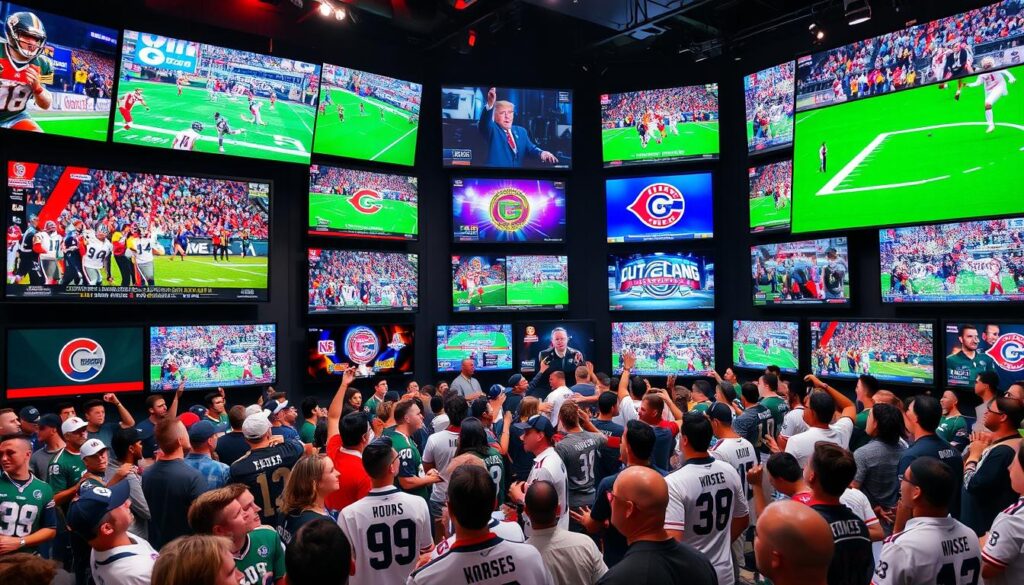
Forecast of Sports Media Revenue in 2024
The financial scene for sports media is about to change a lot in 2024. Trends will guide where the money will go. New tech and what fans want will be key in this shift.
Predicted Growth Areas
New ways to make money are on the horizon. For example, teams and brands will team up more. This is because fans want content that’s just for them.
Digital platforms are also changing the game. They let leagues talk directly to fans. This is making things more interesting for everyone involved.
Sponsorship deals might also go up. With more fans worldwide, leagues could earn more money from sponsors. Also, how colleges make money from sports is changing. This could attract more money and attention to college sports8.

Sports streaming services are growing fast. They’re expected to get more people watching sports. This means leagues need to find ways to make money from these services.
Looking ahead, there will be big changes in sports media. The mix of old and new ways of broadcasting will shape the future. This will make the competition even more exciting.
The future of sports media revenue looks bright for 2024. Companies will need to adjust to reach more fans and make more money9.
The Future of Sports Media Rights Landscape
The sports media rights landscape is set for big changes. Leagues, networks, and tech companies are adjusting to new ways of broadcasting. Media rights fees have jumped by 15% in 2024, with the NFL seeing a 30% rise10. This shows a big change in how fans watch sports, moving more to digital platforms.
Digital streaming is now a big player, outspending TV networks by 25%10. Tech companies are now more involved in media rights talks, up by 50%10. This shows a shift towards on-demand and flexible viewing, meeting today’s audience needs.
The sports media rights market will keep changing. For example, soccer leagues might see a 40% hike in rights fees10. To stay ahead, everyone needs to be quick to adapt. This will help keep fans engaged and boost revenue for all.









